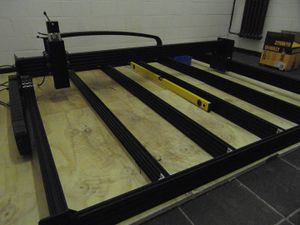CNC Router
A CNC router is a computerized woodworking machine - basically a router mounted on a positioning system. While it may also be able to handle other materials than wood depending on the bits you use, a proper CNC mill is more precise for machining parts out of metals and other non-wood materials.
There is also an interesting new approach of handheld CNC routing coming out which may remove the size constraints that come with any fixed-frame machine.
Uses
You can make furniture or even build a house. For more ideas, check out the CNC Milling Ideas.
WorkBee
| MachineInfoBox Ooznest WorkBee CNC | |
|---|---|

| |
| Synonyms: | DE: CNC-Fräse, Portalfräsmaschine |
| Material: | wood |
| Used with: | 1/4" (maybe also 1/8"?) end mills |
| Access Requirements: | CNC Router Introduction |
| Software: | LaserWeb, Fusion360 |
| Firmware: | grbl |
| Manual: | product page, click "documentation" tab |
| Tutors: | NitramLegov Pakue Johannes Luzian Leo Maker-Joe |
| Similar (More or Less): | router, CNC mill |
We built the 1500mm x 1500mm version of the WorkBee CNC, which is based on the Openbuilds OX. It can currently cut sheet material of up to 20 mm thickness on a work area of approximately 1250 × 1250 mm.
Details on setting it up can be found in issue #8 - maybe you would like to help?
Router
The router mounted to it is a Dewalt D26200 (GB). It came with a 1/4 inch (6.35 mm) and 1/8 inch (3.175 mm) collar, this are the sizes you need to consider when buying your router bits.
As 1/4 inch bits are difficult to obtain in Germany, we also ordered 6 and 8 mm collars.
The collars of the DW613, DW620 and DW621 also fit the router and are easier to get in Germany.
G-Code Sender
After creating the tool paths in a suitable CAM software (e.g. Fusion 360) they need to be sent to the router in real time via the serial interface (USB).
Our experiences can be found on: G-Code Sender
Tips & Tricks
- to avoid tear-out at the edge of a sensitive workpiece, it may be worthwhile to surround it with some sacrificial material (like MDF) before routing [1]
Spoiler board
Ooznest recommends a 6mm spoiler board, our first one is 20mm thick. It is mounted to the frame using 4 drop-in T-nuts. Cutting into the boards will make it uneven, from time to time it is neccessary to surface the spoiler board again.
Helpful Links
- video tutorials:
- Ooznest YouTube channel (pretty new, but specific to our setup
- other spaces with (somewhat) similar machines and good approaches/documentation: